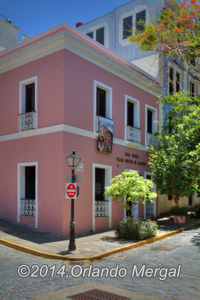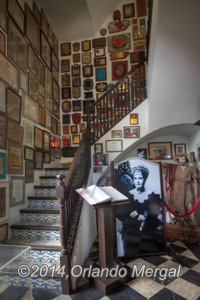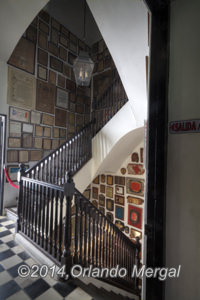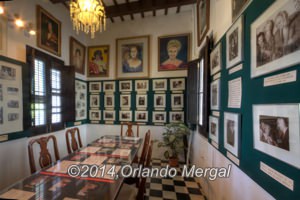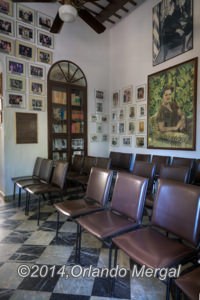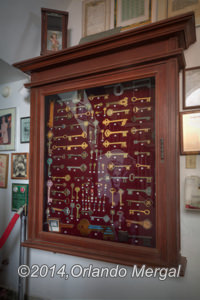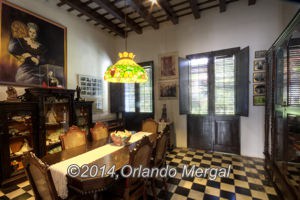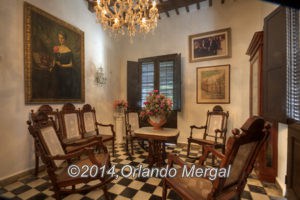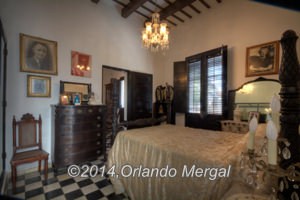museo-felisa-rincon-de-gautier/a>
Last Friday the 13th I once again visited a unique attraction in Puerto Rico. This time my wife and I visited the Felisa Rincón de Gautier Museum on the corner of Clara Lair and “Caleta de San Juan” in Old San Juan. The place is a well deserved shrine to a lady who’s sense of service, honesty and all around commitment to the wellbeing of her people elevated the bar so high that most politicians today can only dream of reaching it.
But Felisa Rincón de Gautier was always adamant that the museum should not be a place where the people could see her old relics, but alive and dynamic. That’s why the Felisa Rincón de Gautier Foundation (the entity that’s actually in charge of the museum) offers conferences and seminars, conducts investigations and celebrates all kinds of events to foster the betterment of public administration in all of Puerto Rico’s municipalities.
“Doña Fela” (as most people called her in Puerto Rico) was born on January 9, 1897 in the municipality of Ceiba, a small town on the eastern coast of Puerto Rico. She was the oldest of 9 siblings. Her father, Enrique Rincón, was a lawyer and her mother Rita Marrero was a school teacher.
At the age of twelve young Felisa was forced to abandon school in the 10th grade and help her father in the upbringing of her eight brothers and sisters, when her mother unexpectedly passed away while giving birth to her youngest sister.
The museum is a popular destination for student groups from all over Puerto Rico as well as tourist groups from all over the world.
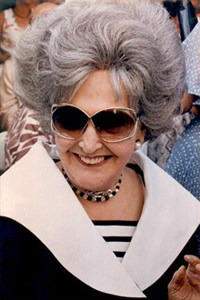
Felisa Rincón de Gautier
Felisa Rincón de Gautier was major of San Juan for 22 years (which is probably a record in itself for the City). But one small fact that many people don’t know (or at least I didn’t know) is that she was never elected by popular vote. That’s right! During the time that Rincón was major the municipality of San Juan was the only one in Puerto Rico that didn’t elect its own major. Instead, the job was an appointed position granted by the Commissioners Board.
In her early years “Doña Fela” didn’t seem to be interested in climbing the Island’s political ranks. Instead she was more of a foot soldier who was always looking for ways to improve the lives of her fellow citizens.
When she arrived in San Juan she established a high fashion store in front of Plaza de Armas called “Felisa’s Style Shop”, where the supermarket is today. She also opened a flower shop nearby that was operated by one of her sisters.
In 1932, when women were granted the right to vote, she immediately registered and cast her vote. She was also a member of the Liberal Party, presided by Antonio R. Barceló, father to Carlos Romero Barceló, who would follow Felisa Rincón de Gautier as major of San Juan and eventually become Governor of Puerto Rico.
In 1938, when the Liberal Party was falling apart, “Doña Fela” worked side by side with Luis Muñoz Marín (who would later become Governor) collecting signatures to register the Popular Democratic Party. Once again she was offered a political position and she declined. She just wanted to help the citizenry.
In 1940 she married Jenaro A. Gautier, a lawyer who was also instrumental in registering the Popular Democratic Party in Puerto Rico.
But on October 14, 1943 something happened in Puerto Rico that changed the political future of Felisa Rincón de Gautier forever. Hurricane San Calixto was headed towards the Island and “Doña Fela’s” neighbors —knowing that she had all the right political connections— asked her to help them find shelter for the storm.
Rincon promptly contacted government officials trying to find shelter for her fellow citizens. But the answer was a polite no. She was told that those things were taken care of “after the fact”. “Doña Fela” was so irritated by the level of incompetence demonstrated by the government that she broke the locks to Luis Muñoz Rivera School, on Manuel Fernández Juncos Ave. and told the people to weather the storm there.
But Rincón didn’t stop there. She went home, bought some groceries, collected some of her own clothes, and that of her husband and brothers, and donated it to the refugees at Luis Muñoz Rivera School.
That day she decided that she would assume a more active role in government.
In 1946 Roberto Sánchez Vilella (who would later become the second governor of Puerto Rico under the Popular Democratic Party) resigned his post as Major of San Juan after only two years in the position and Felisa Rincón de Gautier was named City Manager of San Juan.
Just to set the record straight, neither Roberto Sanchez Vilella nor Felisa Rincón de Gautier were actually majors of San Juan. Instead they were “City Managers”. In those days the people of San Juan would elect a “Commissioners Board” who in turn would name a “City Manager”. It wasn’t until 1968, when Carlos Romero Barceló was elected, that the position was officially changed to Major Of San Juan and the “Commissioners Board” became the Municipal Assembly. Today the Municipal Assembly is actually called the Municipal Legislature.
But stop anyone on the street in Old San Juan and ask who “Doña Fela” was and the universal answer will be “la alcaldesa de San Juan” (THE major of San Juan). Sometimes terms don’t really matter.
Felisa Rincón de Gautier was a mayor for the history books. She was the first female major of a capital city in the New World. Not only in Puerto Rico, but from Alaska to Patagonia.
She immediately surrounded herself with the most competent people that she could find and started laying the groundwork to transform San Juan from one of the poorest capitals in the world to one of the most progressive cities in the hemisphere.
Of course, the purpose of this post isn’t to condense the life of such an illustrious figure into a couple of thousand characters. But just to give you a small sample, here are some of “Doña Fela’s” greatest accomplishments:
- She established the “escuelas maternales” which John F. Kennedy saw during his visit to Puerto Rico in 1961, rebranded as “Head Start”, and established throughout the United States during his short-lived presidency.
- She established 9 Diagnostic and Treatment Centers
- She closed down the old Municipal Hospital on stop 22 in Santurce and relocated it to what today is the Island’s much larger Medical Center (Centro Médico).
- She established the “Clinica Antiillas”, a facility for the terminally ill.
- She built the Hiram Bithorn Baseball Stadium on FD Roosevelt Ave.
- She left the design for the Roberto Clement Coliseum
- She built 4 avenues, namely: Roberto H. Todd, Fidalgo Díaz, Américo Miranda and Gándara.
- She paved all the mayor streets and avenues in San Juan.
- She cleaned all the sanitary sewer systems
- She cleaned all the rainwater systems
- She supplied all sanitation workers with vehicles, equipment, uniforms and gloves. Her policy was always that San Juan would shine if its people shined.
- She took special care of the city’s homeless population
- She built the first municipal parking in the old city (known to everyone in the city as “El Parking De Doña Fela”) as well as the building for the federal court and a small post office next door.
- She built the “pidgeon’s park” (Parque de las Palomas) next to Capilla Del Cristo at the very end of Cristo Street.
- She built the Río Piedras Farmer’s Market
- She rebuilt the Santurce Farmer’s Market
- She rebuilt Convalescence Square in Old San Juan
- And much, much more
On July 1, 1951 the neighboring municipality of Río Piedras was annexed to San Juan and Felisa Rincón de Gautier found herself major of two cities combined into one.
Among the many distinctions and awards that Felisa Rincón received during her lifetime are the following:
- She received 11 honorary doctorate degrees from universities in Puerto Rico and the United States
- The city of San Juan received the “All-American City Award”, when it was selected as one of the cleanest cities in the nation in 1951.
- The Venezuelan medal of Honor
- The Simon Bolivar Award
- In 1954 the American Woman’s Union of New York selected her “Woman of the Americas”.
It’s funny that I started out to cover the Felisa Rincón de Gautier Museum and I ended up writing about her. But when you go there you’ll understand why. They just don’t make politicians like “Doña Fela” anymore.
When you enter the museum you go through what used to be her living room. There you’ll see most of here personal memorabilia like photos form her childhood days, her relatives and the many books that were printed during her tenure.
Then you reach what used to be her dining area. There you have the administrative area to the left, an interior patio to the front and a staircase to the right with hundreds (and I do mean hundreds) of awards. You’ll also see a glass case with the 113 keys that “Doña Fela” was awarded from cities all around the world, and a four-foot statue of Saint John.
On the second floor there are four rooms containing “Doña Fela’s” original furniture, The first one to the left of the staircase has her dining room furniture as well as all the medals, commemorative coins, trophies and mementos that she received from dignitaries and constituents. There’s also her walking cane, some of her Spanish fans and the flags that covered her casket.
Right next to the dining room is a second room with “Doña Fela’s” living room furniture and her Spanish fan collection. There is also an oil painting by Lajos Markus that I can only describe as “regal”.
Immediately to the right is a third room with her bedroom furniture, a couple of mannequins holding two of her original dresses and a “cabezudo” of her likeness made for the San Sebastian Street Fiestas.
Finally, there’s an additional room (that used to be the guest room) that holds pictures and information of all the things that were done during here 22 years in office.
When you come to the Felisa Rincón Museum come prepared to spend a couple of hours if you really want to see the place. Like I said at the beginning of this post: there just aren’t politicians like “Doña Fela” anymore.
The museum is open Monday thru Friday, from 9:00am to 4:00pm. Admission is free but there is a donations box right next to the case holding the keys to the cities.
And finally, they’re also on the net. The museum’s website is http://www.museofelisarincon.com. They are also on Facebook (https://www.facebook.com/museo.felisarincon) and on Twitter (@museofelisa).
And before I forget, you’ll never guess what Felisa Rincón de Gautier is most remembered for. She was the only major that brought real, honest to goodness, snow to Puerto Rico!!! And not once, but three times.
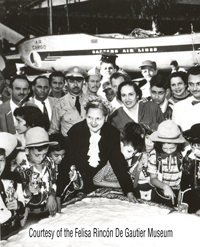
Felisa Rincón de Gautier, the major that brought snow to Old San Juan. Click on image to see it larger.
The story goes like this. “Doña Fela” was the closing speaker at a convention in Florida. Sitting in the audience was Eddie Rickenbacker, the owner of Eastern Air Lines. Rickenbacker was so impressed with “Doña Fela” that he insisted in honoring here with some kind of present.
But “Doña Fela” said that she couldn’t accept it. Rickenbacker insisted. So “Doña Fela” came up with the following idea. She said to Rickenbacker: “by honoring my people you’ll be honoring me. So, since you are the owner of Eastern Air Lines, send a planeload of snow to San Juan during Christmas season”.
And he did!!! The event was so successful that Rickenbacker did it three years in a row. So that’s how “Doña Fela” became the only mayor in Puerto Rican history to bring snow to the Island.
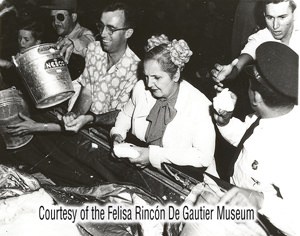
“Doña Fela” not only broght the snow, but she helped spread it at Luis Muñoz Rivera Park. Click on image to see it larger.
And the kids? Well, let’s just say that they had the time of their lives playing in the snow! Albeit, only for a while.
Like always, I’m including a Google Map below to help you find the place, but the fact is that you can’t miss it. It’s the pink building, on your left hand side, right after you enter through San Juan Gate.
‘Till next time, enjoy Puerto Rico.
©2014,Orlando Mergal, MA
____________________
Bilingual Content Creator, Blogger, Podcaster,
Author, Photographer and New Media Expert
Tel. 787–750-0000, Mobile 787–306-1590

